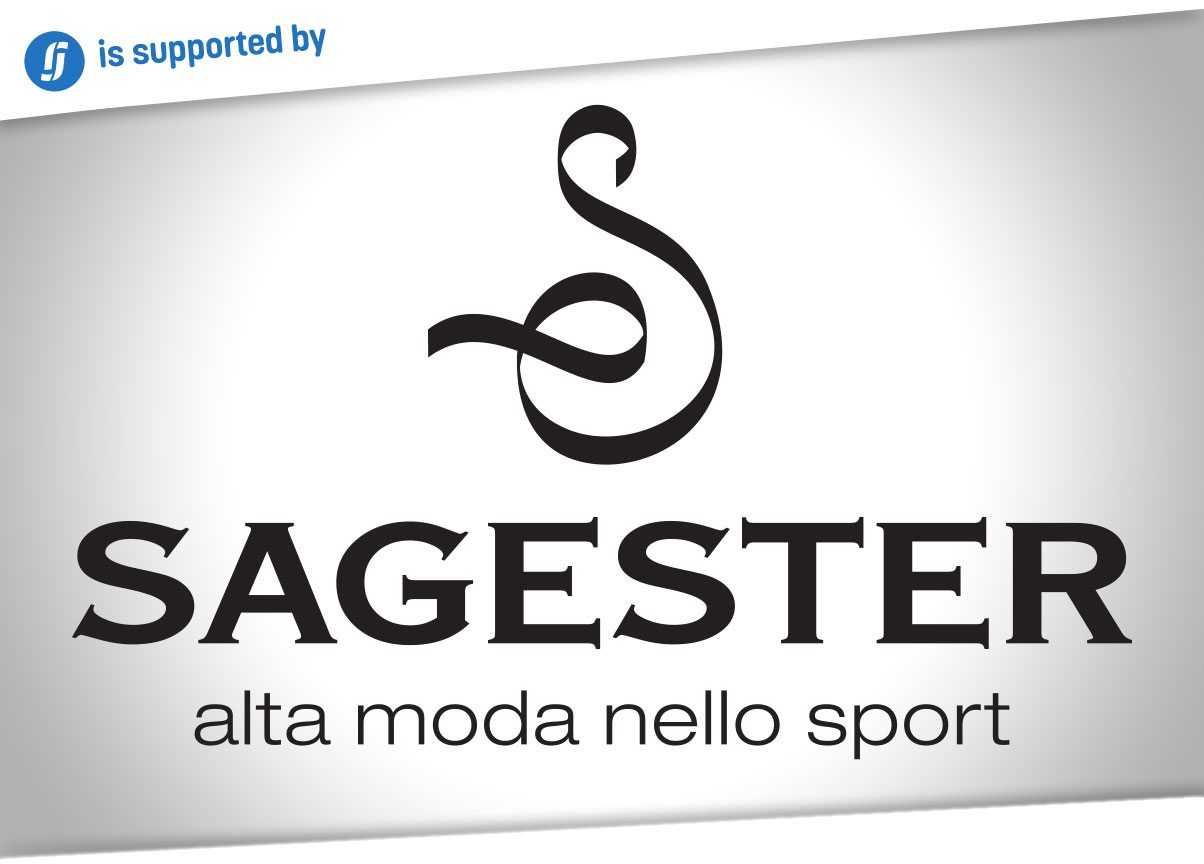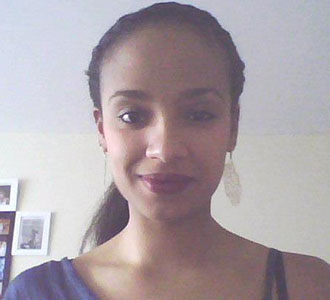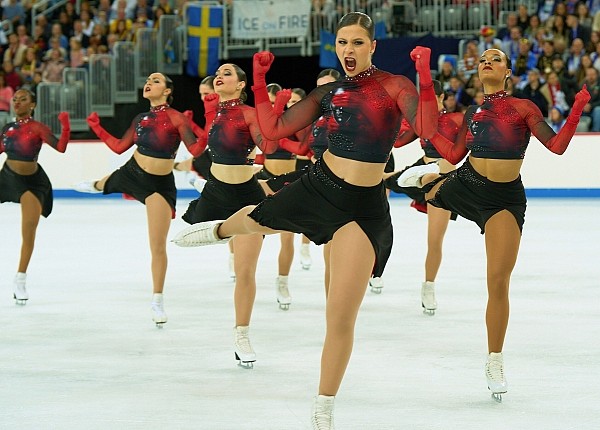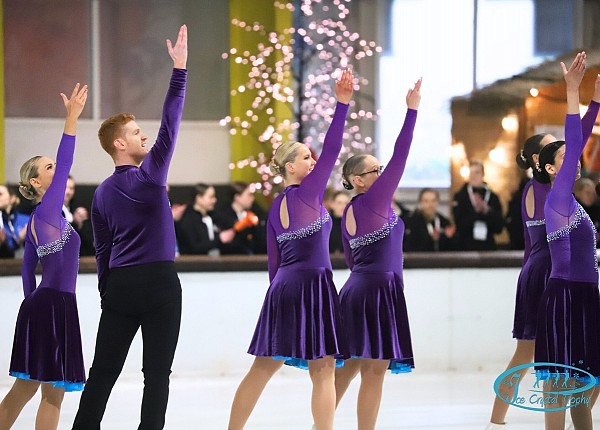Magazine
Imani Rickerby and how to push skaters to shine in their own color

Imani Rickerby is a former synchro skater who wants to bring more diversity into the sport.
After over thirteen years competing in synchronized skating, and be part of Team USA, Imani Rickerby is now very proud to be a black ice skater and run a black-women owned business. Let's learn more about her and her project Aurora Tights.

My mom! We went to an ice skating birthday party, which introduced the idea of ice skating to my mom. At the age of five, I was attending group lessons on a weekly basis, and I have not left the ice since.
I was a competitive synchronized ice skater for over 13 years, with the highlight of my career being a member of Team USA. I competed from on the pre-preliminary to junior level. I also competed on the collegiate level during my time at the University of Maryland. I started coaching group and private lessons six years ago. I have had the pleasure of coaching for the University of Maryland’s synchronized skating team as well! Now that I am back in school (second-year Masters of Health Administration), I keep my feet wet in the skating world by coaching group lessons in Ann Arbor during my free time.
My favorite “skating” memory was performing at my first international competition with my mother in the audience. It meant the world for me that she took off work to travel with me to Sweden. It was an amazing skate for my team and myself, and I honestly could say it was because she was there.
Yes!
It is a must for an ice skater to have rituals. Every time before I step out on the ice for a performance or competition, I HAVE to slap my legs and bend my knees a million times. It is telling my legs and feet that it is showtime! I am a strong believer that your muscle memory carries you during competition. Slapping my legs is my way of waking up my muscle memory and letting the rest of my body live in the moment and enjoy the ride.
Another funny ritual I had is that if I ate an egg, cheese, and sausage breakfast sandwich on the day of competition, I knew it was going to be a great skate.

Yes. I have had coaches who did not want to coach me because I am Black. I have had teammates telling me that they would never want my hair texture. Because I was told I “stand out”, I felt extra pressure to have perfect timing, extensions, and movements in an effort to not highlight myself. My family and I have been called derogatory slurs by other teammates.
The list goes on and I am not alone.
Black and Brown skaters (and other skaters color) are still experiencing racism to this day. Our sport needs to take immediate actions to remove the inherent racism that lays within its foundations. Only through substantive change like diverse representation in coaches and judges, data tracking to uncover the attrition rate for skaters of color, and rules to protect skaters that “stand out,” will skating promote diversity, equity and inclusion on the ice.
I do not think someone can “handle” racism. It is something that you go through without your permission.
I coped. I tried to push racist acts and microaggressions to the back of my memory. It is really hard being a Black skater.
During competitions, I remember always feeling like I had a bag of weight on my shoulders - only this stress did not derive from competition nerves. Instead, it stemmed from my anxiety of knowing that I was about to try to fit a beauty standard that was unattainable. I had to put on makeup and change my hair to a standard that I could never meet. I had to wear dresses and tights that were way too light for my skin complexion. I had to be evaluated by a judging panel and technical specialists that did not look like me. All of this angst, on top of the fact that I was about to compete, was a lot of pressure.
So to cope, I put my energy into over-performing. I set a really high standard for myself. This sport might not like what I look like or who I represent, however, it can not deny my talent.

Do not be afraid to change your team’s designated makeup or hairstyles so it compliments your features. You are just as an important member like everyone else on your team, so you deserve to feel confident in your own skin! I am not saying change the entire color scheme of the prescribed makeup, rather, use hues that compliment your skin tone.
This advice goes for ALL skin complexion.
In regards to hairstyles, do not damage your own hair for a hairstyle that you will wear for a 3-minute program. It is not worth it.
Your body is your temple, so treat as such!
Everything. Confidence, resilience, teamwork, humility. I cannot name them all!
I really admire synchronized ice skating and other team sports because it teaches you a beauty of discipline while enforcing social skills that will help you excel in other aspects of your life.

Have fun and fall in love with it!
Yes, ice skating is a lot of hard work, but it is one of the most exhilarating sports out there (I am biased of course)!
Do not force yourself to do something that your heart is not committed to.
I also want to advise skaters of color that you are not only skating for yourself. There are little Black and Brown girls that are being inspired by your trajectory and performance. So be proud of who you are and who you represent!
This is a hard one. I had a turning point before entering college if I wanted to continue my skating career at the senior level. If I did so, I would have gone to college in the New Jersey area and devote my life to ice skating, something I already was doing for the past 10 years. I also knew that competing on the senior level would be a huge financial commitment, not even mentioning the cost of attending college. I decided to forego competing at the senior level and put my education first. I wanted to find out who I was outside of ice skating. I also did not want to put such a financial strain on my parents’ pockets! I was fortunate to attend a university that had a collegiate team where I still skated at a very low maintenance level. I ended up coaching two synchro teams before starting graduate school.
Now, I am working with synchro teams to embrace diversity and push their skaters to wear tights that match their beautiful skin complexions. So I guess I never stopped synchro.
Once a synchro skater, always a synchro skater!

"Aurora Tights" is an athletic apparel company that provides apparel in all shades and all sizes. We currently offer ice skating and dance tights in five styles, five shades, and seven sizes. We also offer athleisure apparel that highlights your skin while you perform in color!
"Aurora Tights" founders include me, and my two best friends. We all attended the University of Maryland and are sisters of Delta Sigma Theta Sorority, Inc.
Jasmine Snead grew up as a figure skater and Sydney Parker was a competitive dancer. The Aurora team has over 60 years of performing experience combined.

Jasmine, a figure skater of over 20 years, used to dye her tights in a bathtub before every competition, and the process was time-consuming, messy, experimental, and expensive. On the opposite end of the spectrum, I was not allowed to wear tights that matched my skin tone so I had to wear tights that were too pale for my complexion. While we had different experiences, we were unified in feeling marginalized, unheard, and unseen in the sport we loved.
While coaching a team of young synchronized ice skaters, Jasmine and I noticed that many of their students, particularly those of color, were reliving their experiences of isolation. Due to the lack of diverse skating gear, their students were lacking confidence, loneliness, and identity issues. Many times, athletes of color draw away from the sport - not because of a lack of talent - but due to the lack of community. Inspired by our students, we both quickly realized that there was an unmet need and shared our stories with Sydney, our best friend, and lifetime competitive dancer.
Sydney had a similar experience while dancing, with the added pressure of being a dark-skinned woman in a predominately white sport. The hair products, makeup, and especially the apparel never fit her appearance. Sydney’s feelings of isolation rose so high she avoided even looking in the mirror. It was only after finding her community on her collegiate team of predominantly black women that Sydney started to have confidence in not only her skills but also her appearance. She understood then what it meant to have a support channel to turn to in times of need.
Together, we decided to be the catalysts to end the destructive cycle of monoculturalism within performance sports and instead build a community of empowerment.
Aurora Tights was created in January 2018. The name Aurora Tights is a play on the Aurora Lights, a natural display of bright and colorful dancing lights in the Earth's sky. Since its inception, Aurora Tights has been an inclusive performance apparel brand, but more importantly, a safe space that empowers all athletes to perform in color.
Aurora Tights strives to change the definition of beauty in performance sports as they are diversifying rapidly. We fill a long-standing need for an unheard market by offering shade and size inclusivity in performance athletic gear, such as tights. Currently, there is a whole population of performers who do not have tights that match their skin color or do not like the shades that are available to them. We strive to make sure adults and children, just like us, feel comfortable in their skin and excel at their athletic passions.
We also take a stand on being a safe community for adults and children of all shades and sizes. While we are a for-profit company, our social impact mission is directly baked into our business model. Supporting and empowering minority athletes to stay involved in their passions is the fundamental driver of Aurora.
Ultimately, Aurora Tights strives to make sure all athletes feel comfortable in their skin, excel at their athletic passions, and have a long-lasting tenure in their sport.

I see Aurora Tights becoming an internationally recognized brand that all performers use to supply their athletic apparel and find a community that embraces diversity in all sports. Aurora Tights will become a one-stop-shop. You can grab a new pair of tights and some new practice gear for the season with ease. I also see Aurora Tights changing the narrative around beauty in performance sports. Sports need to embrace diversity and push performers to shine in their own color.

This Sunday, learn more about Imani Rickerby on the OneTeamMVMT Instagram account by following her "Take Over"!




